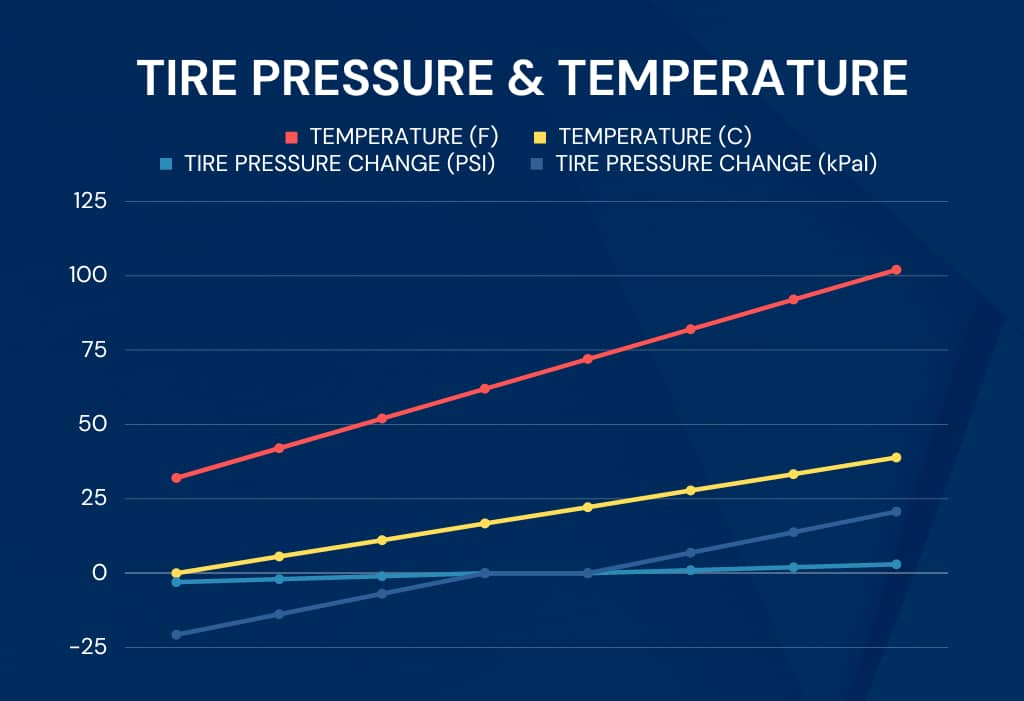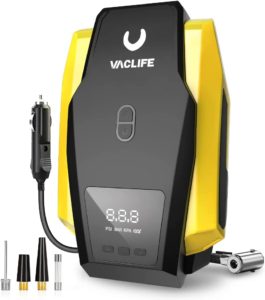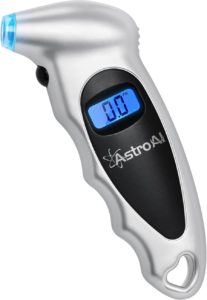Steps to Reset Hyundai Sonata Tire Pressure Light
Step 1: Check and Adjust the Hyundai Sonata Tire Pressure
The Hyundai Sonata does not have a tire pressure reset button. To turn off the tire pressure light, you need to make sure that all four of your tires are filled to the proper pressure levels. To find the correct pressure, you can look at the yellow sticker on the inside of the driver’s side door, refer to the chart below, or use the Mode button on your steering wheel to navigate to the tire pressure display. Make sure you fill each tire to the exact recommended pressure. (The Sonata requires 35 Psi in all 4 tires.) It’s important to adjust your tire pressure only when the tires are cold, meaning before you’ve driven the car or after the car has been parked for a few hours.
Step 2: Drive the Hyundai Sonata
Once you’ve set your tires to the correct pressures, drive your Sonata. Drive for a few minutes at speeds over 20 mph. You might see a message saying “drive to display.” This will turn off. As you continue driving, the tire pressure light will turn off. If it doesn’t disappear immediately, just keep on driving a bit longer.
Step 3: Re-check Tire Pressure
If the tire pressure light remains on after following steps 1 and 2, double-check your tire pressure to ensure they’re still at the EXACT level you set them to. If there not, there is probably a leak in the tire or valve stem. In case the tire light turns off after inflating the tires but then comes back on, you probably have a tire leak. If the tire pressure light blinks or flashes before staying on, it indicates that your tire pressure system is malfunctioning. (keep reading to learn how to deal with this)
2023 Hyundai Sonata Tire Pressure
Match your tire size to the chart below:
Tire Size | FRONT PSI | REAR PSI |
205/65R16 | 35 | 35 |
215/55R17 | 35 | 35 |
235/45R18 | 35 | 35 |
245/40R19 | 35 | 35 |
SPARE TIRE | 60 | 60 |
Hyundai Sonata TPMS Malfunction Indicator
The tire pressure monitoring system (TPMS) in the Hyundai Sonata has a built-in malfunction indicator. This indicator uses the same yellow exclamation point tire warning light as the low pressure warning. If the TPMS experiences an issue, the warning light (yellow exclamation point) will flash for around a minute before staying on. This flashing sequence will occur every time you start your car until the problem is fixed.
It’s crucial to understand that while the indicator is on, the TPMS will not work correctly, which means your tire pressure monitoring system won’t function as it should until the TPMS issue is resolved. In other words, if your tire pressure light is blinking, it signifies a problem with the TPMS itself, typically a faulty pressure sensor in one of your tires, rather than an actual air pressure concern.
To figure out which tire sensor is causing the issue, you’ll need a TPMS diagnostic tool, like the Autel TPMS tool. (I’ve been using Autel TPMS diagnostic tools for a few years, and I can’t recommend them enough.)
Reset Your Sonata TPMS in These Cases:
After adjusting tire pressure
After tire rotation, tire replacement, wheel balance, or alignment
After a TPMS sensor has been replaced or serviced
After replacing a rim/wheel or changing tire size
If the vehicle’s battery has been disconnected, swapped out or jumped
When the TPMS malfunction indicator is activated
How the Hyundai Sonata TPMS Works
The Hyundai Sonata’s tire pressure monitoring system (TPMS) is designed to ensure optimal tire pressure, enhancing safety and fuel efficiency. Here’s a detailed breakdown of how it works:
Direct TPMS: The Hyundai Sonata uses a direct TPMS, which means it has tire pressure sensors located inside each tire that constantly monitor tire pressure levels.
Wireless Transmission: The sensors wirelessly transmit tire pressure data to the vehicle’s onboard computer, allowing for live monitoring.
Tire Pressure Display: The TPMS data can be accessed through the vehicle’s display system, providing you with the current tire pressure of each tire.
Low Pressure Warning: If any tire’s pressure falls below the recommended level, the TPMS will trigger a warning light (a yellow exclamation point) on the dashboard to alert the driver.
Malfunction Indicator: The TPMS also has a built-in malfunction indicator that uses the same warning light. If the system encounters a problem, the light will blink for about a minute and then remain on.
Sensor Battery Life: The TPMS sensors are battery-powered and typically last around 5-10 years. When the battery runs low or fails, it will trigger the malfunction indicator.
Seasonal Changes: The TPMS can help identify significant changes in tire pressure due to seasonal temperature fluctuations, ensuring that tires remain at optimal pressure levels throughout the year. (read below to learn more about this)
What Causes the TPMS Light to Turn On?
The Hyundai Sonata TPMS light can come on for many different reasons, letting you know there is a problem. Here’s a list of potential causes:
Low Tire Pressure: The most common reason for the TPMS light to come on is when one or more tires have pressure below 35 Psi. This can result from a slow leak, puncture, or natural pressure loss over time.
TPMS Malfunction: If the TPMS itself is experiencing a problem, the warning light will flash for about a minute and then stay lit. This could be due to a faulty sensor, a dead or dying sensor battery, or communication issues between the sensor and the vehicle’s computer.
Seasonal Changes: Fluctuations in temperature can cause changes in tire pressure. This is extremely common! Cold weather often leads to a decrease in tire pressure, while warmer temperatures can result in increased pressure. (read more on this below)
Tire Rotation or Replacement: The TPMS light might come on after a tire rotation or replacement if the system needs to be reset. Sometimes the system will accidentally think the front tires are in the rear and vice versa after a rotation.
New Wheel or Tire Sizes: If you have installed new wheels/rims or changed tire sizes, the TPMS light will turn on if the system has not been recalibrated to account for the changes. This will also be a problem if you replace a wheel/rim and don’t swap sensors over from the old wheel/rim to the new wheel/rim.
Disconnected or Replaced Vehicle Battery: The TPMS light might be triggered if the vehicle’s battery has been disconnected, jumped, or replaced, as this may require the system to be reset.
Sensor Damage: Physical damage to a TPMS sensor, such as from an impact, corrosion, or improper installation, can cause the TPMS light to come on. I have seen many times, the rubber gasket between the valve and sensor go bad, causing a leak. The rubber gasket is replaceable without having to replace the entire sensor.
How Does the Weather Affect Your Tire Pressure?

The graph above shows how air temperature affects tire pressure. What it shows is that when it gets colder outside, tire pressure decreases, and when it gets warmer, tire pressure increases. A good reference point to keep in mind is around 62°F (16.7°C), as that’s the temperature where tire pressure generally stays the same. So, for every 10-degree drop in air temperature, your tire pressure will go down by about 1 PSI.
What are the Benefits of Hyundai Sonata TPMS?
Boosted safety: The TPMS ensures appropriate tire pressure, reducing the chances of tire blowouts, enhancing traction, and providing better handling while driving your Hyundai Sonata.
Greater fuel efficiency: By keeping an eye on and maintaining the ideal tyre pressure, the TPMS contributes to improved fuel efficiency.
Extended tire lifespan: Maintaining the correct tyre pressure helps prevent uneven tread wear on your tires, ultimately extending their life and reducing replacement costs.
Eco-friendly impact: Enhanced fuel efficiency and minimized tire wear lead to a reduced carbon footprint, using less.
Early detection system: The TPMS warns you of low tyre pressure or potential system issues, allowing you to tackle problems before they escalate or become expensive to repair.
Better driving comfort: Proper tire pressure results in a smoother ride.
Assurance on the road: Being aware that your Hyundai Sonata’s TPMS is constantly monitoring tire pressure gives you added confidence and peace of mind while driving.
Everything in this article is applicable to all Hyundai Sonata models and trims, including the Sonata Hybrid.
Please note that this blog post contains Amazon affiliate links. This means that if you make a purchase through one of these links, we at TPMSRESET.com may earn a small commission at no extra cost to you. We only recommend products that we personally use and believe in. Thank you for supporting this us.




